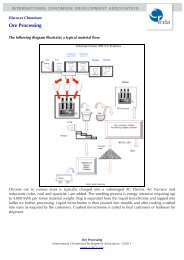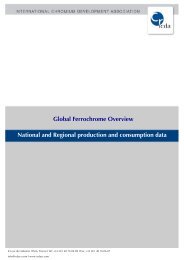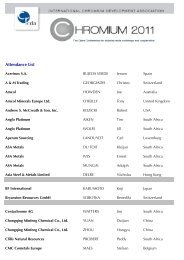PDF: *New: RECYCLING FERRITIC Stainless Steel - Euro Inox
PDF: *New: RECYCLING FERRITIC Stainless Steel - Euro Inox
PDF: *New: RECYCLING FERRITIC Stainless Steel - Euro Inox
Create successful ePaper yourself
Turn your PDF publications into a flip-book with our unique Google optimized e-Paper software.
Recycling Ferritic<br />
<strong>Stainless</strong> <strong>Steel</strong>
Team <strong>Stainless</strong> promotes the many benefits of stainless steel to a sustainable society. Team<br />
<strong>Stainless</strong> is an informal cooperation among associations of the stainless steel and alloying<br />
element industries. It has a global mission.<br />
This publication has been developed<br />
by the members of Team <strong>Stainless</strong>.
Contents<br />
The key messages of this brochure 1<br />
Ferritics step to the fore 2<br />
Economic and environmental good sense 3<br />
The recycling of stainless steel 4<br />
Recycling practices around the world 5-8<br />
The future of ferritic recycling 8
The key messages of this brochure<br />
For fabricators<br />
• Provide a bin for ferritic waste.<br />
• Collect ferritic off-cuts by grade, especially that containing<br />
molybdenum.<br />
Yes, I need<br />
ferritic bins!<br />
For the general public<br />
• Recycle your ferritic stainless steel (i.e. do not let it end<br />
up in landfill).<br />
NO<br />
<strong>FERRITIC</strong>!<br />
For municipal waste-recycling centres<br />
• Perform more manual separation.<br />
For scrap processors<br />
• Pursue research into continuousbelt<br />
sorting for magnetic scrap.<br />
• Encourage fabricators to sort<br />
ferritic stainless.<br />
X-RAY<br />
For stainless steel producers<br />
• Ensure you use ferritic scrap<br />
and benefit from its environmental<br />
advantages (EAF: Electrical Arc<br />
Furnace).<br />
p. 1
Ferritics step to the fore<br />
The purpose of this brochure is to help develop and grow the<br />
systematic separation of ferritic stainless steel scrap in the<br />
metals recycling chain, both in the factory and at the end-of-life<br />
of products.<br />
In simplistic terms, stainless steels come in two main forms:<br />
austenitic (alloyed with chromium and nickel) and ferritic<br />
(alloyed with just chromium). The increasingly popular ferritic<br />
grades of stainless steel contain no nickel. Their “stainless”<br />
corrosion-resistance comes from their chromium content<br />
– chromium being the alloying element responsible for the<br />
corrosion resistance of all stainless steels. The more of this<br />
valuable element we can recycle the better.<br />
Ferritic grades of stainless steel have long been a material<br />
of choice for certain major applications, notably automotive<br />
exhaust systems and white goods – for example, washingmachine<br />
drums.<br />
In the past, ferritic stainless steels have tended to be<br />
overlooked, due to the erroneous belief that they were<br />
insufficiently corrosion resistant and hard to work in<br />
manufacturing. Another reason was the limited range of<br />
grades and a lack of availability. In recent years, due to<br />
instability on the alloying-element markets and the relative<br />
price-stability of ferritic stainless steel, new grades have<br />
been developed, extending potential ferritic applications.<br />
Hence, the stainless steel industry continues to look for<br />
lower-cost alternatives to certain traditional grades which<br />
do not jeopardise technical performance.<br />
MANY GRADES, MANY APPLICATIONS<br />
Important manufacturers in these sectors already return<br />
ferritic stainless steel scrap systematically to the melting shop.<br />
Between 2007 and 2010, however, there was a significant<br />
increase in the use of ferritics in new applications (highlighted<br />
in the graph below), often involving small and medium-size<br />
manufacturers. These industries do not usually separate ferritic<br />
stainless scrap.<br />
100%<br />
90%<br />
80%<br />
70%<br />
60%<br />
23<br />
5,5<br />
22,1<br />
5,7<br />
22<br />
6,5<br />
23<br />
9,4<br />
24,5<br />
10,9<br />
22,8<br />
10,4<br />
28,1<br />
12,5<br />
27,8<br />
13,2<br />
27,9<br />
13,6<br />
29,9<br />
13,4<br />
26,9<br />
17,4<br />
25<br />
20,4<br />
Ferritic grades fall into five groups – two families of standard<br />
grades and three of “special” grades. Standard grades<br />
mainly contain only chromium. The special grades contain<br />
other elements, such as molybdenum, titanium, niobium,<br />
etc.<br />
The well-known standard ferritic grades readily available all<br />
over the world are: 409/1.4512, 410/1.4000 and 430/1.4016.<br />
In recent decades, further grades have been developed:<br />
434/1.4113, 436/1.4513, 439/1.4510, 441/1.4509 and<br />
444/1.4521. Even more recent grades, with higher chromium<br />
content, such as 445/1.4621 and 446, meet an even broader<br />
range of requirements.<br />
50%<br />
40%<br />
30%<br />
20%<br />
70,6<br />
71,3<br />
70,6<br />
65,5<br />
62,3<br />
64,7<br />
56,9<br />
56,5<br />
57,4<br />
55,2<br />
54,3<br />
53,2<br />
10%<br />
0%<br />
2001 2002 2003 2004 2005 2006 2007 2008 2009 2010 2011 2012<br />
Source: ISSF<br />
CrNi CrMn Cr Others<br />
The worldwide production of crude stainless steel from 2001, by three main categories<br />
of stainless steel: chromium-nickel (300 series - austenitic), chromium-manganese<br />
(200 series - austenitic) and chromium only (400 series - ferritic)<br />
Examples of stainless steel applications: building facade, catering equipment,<br />
water pipes, elevator, truck AdBlue tank, water tank.<br />
p. 2
The reputation of ferritics has risen significantly in recent<br />
years. This is partly due to global communication by the<br />
stainless steel industry on the properties and workability of<br />
these fine grades – which has paved the way for many new<br />
applications. Ferritics are now extensively used in kitchenware<br />
and catering equipment, barbecue grills, building facades<br />
and interiors, furniture and decorative items, automotive trim,<br />
superheater and reheater tubes, burners, air-conditioning<br />
ducts, water tanks and many other contexts. As even more<br />
new applications emerge and ferritic use increases, it is<br />
becoming more and more necessary – and viable – to extend<br />
the recycling of these grades.<br />
THE <strong>FERRITIC</strong> PREDICAMENT<br />
For austenitic grades (which have valuable nickel content),<br />
the recycling chain is securely in place. This is not the case<br />
for ferritics. Generally, in scrap yards, magnetic scrap (for<br />
example carbon steel) and non-magnetic scrap (for example<br />
austenitic stainless steel) are separated from each other by<br />
magnet. Therefore, ferritic stainless steel scrap – magnetic,<br />
like carbon steel – is inevitably left mixed with the carbon steel<br />
scrap, unnoticed. It is the Cinderella of stainless steels in the<br />
scrap yard.<br />
Economic and<br />
environmental good<br />
sense<br />
Today, the material flow for stainless products demonstrates<br />
that the recycling of pre- and post-consumer stainless steel<br />
scrap is already common practice.<br />
In the production of stainless steel, a scrap blend and other<br />
raw materials – chromium, molybdenum, nickel and other<br />
elements – are melted together in an electric furnace before<br />
going into a converter for refining. The molten stainless steel<br />
is then cast into slabs or billets, before the production of plate,<br />
sheet, coil, wire or other product forms, in preparation for use<br />
by industrial manufacturers. These manufacturers produce<br />
the stainless steel items we use every day, including cutlery,<br />
pots & pans and kitchen sinks, and inumerable architectural,<br />
industrial and other components.<br />
The following data (source Reck et al. 2013, Yale<br />
University) shows that stainless steel scrap is already<br />
favoured in the production of stainless steel. Scrap used<br />
for stainless production:<br />
2005 2010<br />
Overall scrap 57% 51%<br />
<strong>Stainless</strong> steel scrap 38.3 % 33%<br />
Carbon steel scrap 18.6 % 18%<br />
Scrap input in 2010 was lower than in 2005, due to China’s<br />
growing production. China currently uses much less scrap<br />
than other regions (estimated to be about 25% in 2010).<br />
AN END USER’S VIEW<br />
“For the production of its houseware, IKEA has shifted from 90% austenitic,<br />
in 2005, to 95% ferritic in 2012. Some 85% of this production is carried out<br />
in mainland China.<br />
“Ferritic scrap is valuable and OEM’s waste is totally recycled. Our Asian<br />
OEM suppliers sell 2/3 of their “new” ferritic scrap to dealers, who transfer it<br />
to qualified scrap collectors. The other 1/3 of their production waste is reused<br />
internally for components. Final waste, that they can’t use, is sold to this<br />
Raw material extraction<br />
<strong>Stainless</strong> steel<br />
production<br />
Postconsumer<br />
scrap<br />
Production of<br />
stainless steel<br />
goods<br />
Preconsumer<br />
scrap<br />
qualified network of scrap collectors.<br />
“China is moving towards a more structured recycling industry and its<br />
scrap-collection system is much more organized than in the past. Indeed,<br />
international scrap processors have recently started investing in China.<br />
Continuous growth in the use of ferritics is expected over the next 20<br />
years, so it seems clear that the recycling of ferritic stainless steel will make<br />
economic and environmental good sense.<br />
End-of-life phase<br />
The flow of stainless steel through society<br />
Use phase of end-products<br />
Unlike many industrial and engineering materials, stainless<br />
steel can be re-melted over and over again at each stage of<br />
this cycle without any loss in quality. It is 100% recyclable.<br />
“Most of IKEA’s stainless steel articles are sourced from Asia, including<br />
China (90%), Taiwan and Korea. The steel situation in mainland China and<br />
Asia generally is in transition. <strong>Stainless</strong> scrap is recycled because of its value<br />
and quality, rather than because the system is organised for that. It’s not yet<br />
as standardised as it is in <strong>Euro</strong>pe. Requirements are less strict. Much of the<br />
stainless steel in circulation is ‘first generation’. The recycling of goods like<br />
washing machines, has not yet started because, being relatively new here,<br />
they’re all still in use.”<br />
Gaetano Ronchi, former IKEA consultant<br />
p. 3
Further downstream in the recycling process, the presence<br />
of ferritic material amongst carbon steel scrap pollutes the<br />
carbon steel during re-melting. At the same time, valuable<br />
chromium is lost and cannot be usefully recycled.<br />
BENEFITS ALL ROUND<br />
the end of their useful life. Many are already systematically<br />
separated and recovered, to go back into the production<br />
process. This recycling is performed on a large scale around<br />
the world.<br />
“NEW” AND “OLD” SCRAP<br />
The recycling of more ferritic scrap would be generally<br />
advantageous, reducing the cost of producing stainless steel,<br />
preserving valuable alloying elements and helping protect the<br />
environment.<br />
Developing the separate recycling of ferritic stainless steel<br />
– and a separate market for ferritic scrap – is a logical and<br />
attractive opportunity in metals recycling. Given the recent and<br />
forecast growth in the use of ferritics in new applications, the<br />
small and medium-sized industrial manufacturers concerned<br />
should be encouraged to sort ferritic scrap.<br />
The recycling of<br />
stainless steel<br />
Until the late 20 th century, the evolution of modern massproduction<br />
technologies encouraged a “throw-away” society.<br />
This attitude has now changed.<br />
The advent of product stewardship (using products safely<br />
throughout their life and then disposing of them responsibly)<br />
plus the increasing drive to save materials and energy<br />
are both factors favouring scrap recovery and recycling.<br />
Today, environmental factors are at the forefront of material<br />
selection for specifiers. <strong>Stainless</strong> steel’s long service life, its<br />
100% recyclability and its valuable raw materials make it an<br />
excellent environmental performer.<br />
Fewer and fewer stainless steel objects become waste at<br />
THE SCRAP PROCESSOR’S ROLE<br />
For scrap processors, waste is a ‘primary material’ in an advanced society.<br />
These companies are miners, but on the surface of the Earth.<br />
Their yards receive scrap – steel, non-ferrous metals and plastics at the endof-life<br />
of equipment such as cars, electronic equipment and white goods.<br />
They send the materials they extract, such as copper or stainless steel, into<br />
specific product chains, where they undergo processing. The processed<br />
results are sent to customers for recycling.<br />
<strong>Stainless</strong> steel is one of the friendliest materials for the Earth. At the end of<br />
its long life, it is recycled to create new stainless steel. In this context, the<br />
recycling industry has become a vital player in providing a stable supply of<br />
high-quality secondary raw material. Today, when you sell something – for<br />
example a dishwasher – you have to think about the end of its life and charge<br />
a fee to cover its recycling. This is a relatively recent practice. Previously,<br />
products were simply thrown into landfill or a shredder.<br />
The business of the scrap processor is to collect and buy scrap and offer<br />
a tailor-made product to stainless steel producers. They collect waste from<br />
different sources, including OEMs and eco-organisations with which they<br />
have contracts concerning end-of-life products such as washing machines<br />
and fridges. In processing the scrap and preparing accurate austenitic<br />
stainless steel scrap blends, they must ensure a very low level of residuals.<br />
Apart from the traditional uses of ferritic stainless steel, where the industrial<br />
waste is already sorted, for the scrap processor ferritic scrap volumes are<br />
currently low. For this to evolve, they will have to wait for the end-of-life of<br />
new applications and, above all, talk to manufacturers in these sectors.<br />
The global stainless steel cycle in 2010 (source Reck et al. 2013, Yale<br />
University, 2010).<br />
Today, ferritic stainless steel goes into the scrap processors’ austenitic<br />
blends. It would definitely be in their interest to rescue more chromium, for<br />
example by separating it from carbon steel scrap.<br />
p. 4
The sorting of both ferritic and austenitic industrial shop-floor<br />
waste (called “new” scrap) is already common practice for<br />
many OEMs. The second type of scrap (“old” or reclaimed<br />
scrap) includes industrial equipment, tanks, washing<br />
machines, exhaust pipes and kitchen sinks, etc., which have<br />
reached the end of their service life.<br />
VALUABLE STAINLESS ALLOYING ELEMENTS<br />
Metal recycling is a vital component of the global metal<br />
industry. From the stainless producer’s point of view, making<br />
stainless steel from scrap uses less energy than creating it<br />
afresh, through mining, smelting and refining the original raw<br />
materials, which, as explained, include chromium, nickel and<br />
molybdenum. These alloying elements are non-renewable<br />
resources. It is becoming increasingly important to save more<br />
stainless steel from waste.<br />
out of production. It goes back into the loop within 3 to 5<br />
months.<br />
- “Old” (or reclaimed) scrap – material recovered after use<br />
in end products. This collected scrap comes to recycling<br />
companies from small and medium-sized scrap-collecting<br />
companies who collect waste, including plastic, rubber and<br />
metal, from various sources. Dealing in small tonnages, they<br />
sell this material to scrap processors. There are thousands<br />
of these companies everywhere, providing a decentralised<br />
service.<br />
Scrap can come back in just a few years, in the case of<br />
electronics, to almost a century when applied in buildings.<br />
Average lifetimes have been estimated to be 50 years for<br />
buildings and infrastructure, 14 years for vehicles, 30 years<br />
for other transportation modes (rail, ship, aircraft), 25 years for<br />
industrial machinery and 15 years for household appliances<br />
and metal goods.<br />
Recycling practices<br />
around the world<br />
EUROPE<br />
In recent years, the importance of sorting and recycling<br />
alloyed and non-alloyed metals has grown, because of the<br />
monetary value of these materials. Today, everyone is aware<br />
of the value of scrap such as copper, aluminium and stainless<br />
steel.<br />
According to <strong>Euro</strong>pean scrap recyclers, the stainless steel<br />
scrap categories are:<br />
- “Revert” scrap coming directly from the production of the<br />
stainless steel mill (coil/sheet).<br />
- “New” scrap – when a manufacturer fabricates a finished<br />
product, some steel will be cut off. This waste comes straight<br />
The impact of CO 2<br />
emissions is becoming more and more<br />
important and will have an effect on costs in the near future.<br />
Using stainless steel scrap, emissions are much lower than<br />
using primary metal.<br />
Today, recycled stainless<br />
steel is a global market. In<br />
<strong>Euro</strong>pe and other developed<br />
countries, stainless steel<br />
scrap processing involves<br />
accumulating sufficient<br />
material to go into a furnace.<br />
The processor supplies a<br />
highly accurate and consistent<br />
blend of chromium-nickel alloyed metal to the customer.<br />
What the customer puts into his furnace is 8% nickel, 17%<br />
chromium (304 grade scrap) or 2% molybdenum, 10% nickel,<br />
17% chromium (316 grade). These two major austenitic<br />
categories represented 71% of production in 2000 (see graph<br />
p. 2) but recently shifted to 55%, with the development of<br />
ferritics (the 400 series) and chromium-manganese (the 200<br />
p. 5
series). The growth of ferritics means that there is now a more<br />
even balance in the scrap mix.<br />
Every grade coming into a scrap yard has to be separated.<br />
But the scrap processor sells austenitic, not ferritic. Currently,<br />
there is no real market for ferritic scrap. The processor<br />
therefore incorporates it in his austenitic blend.<br />
JAPAN<br />
Japan is very conscious of the need to recycle and has an<br />
approach to recycling resembling that in <strong>Euro</strong>pe. While there<br />
are as yet no specific environmental policies concerning scrap<br />
(other than that for radioactive scrap), a “consumer electrical<br />
appliance recycling regulation” has been introduced requiring<br />
consumers to pay a recycling fee, to promote the recycling of<br />
valuable elements.<br />
In terms of stainless steel, local producers of ferritic grades<br />
are very interested in the recycling of ferritics. The value of<br />
ferritic waste has risen significantly in Japan in the last 10<br />
years, due to Japan’s long history of innovation and to the<br />
growth of local ferritic use. Several new applications using<br />
ferritic have emerged, including heat pumps, water tanks,<br />
induction cooking utensils and kitchenware. Based on a 2006<br />
estimate, there is an increase in the amount of ferritic being<br />
recycled.<br />
Since ferritic scrap is magnetic, it is lost in the carbon steel<br />
scrap if it is not coming from a major application such as<br />
washing machine drums – where it is already separated. A<br />
mix of carbon and ferritic stainless steel scrap destroys the<br />
value of the ferritic. It brings down the chromium content and,<br />
at the same time, is not useable for carbon steel production,<br />
since chromium is an impurity.<br />
Today, there is interest in research into technology for<br />
separating ferritic scrap from other magnetic metals. It is a<br />
question of quantity, of course, but if it becomes possible,<br />
separating ferritic from such a mix would create higher value<br />
from ferritic scrap and motivate scrap-processing companies<br />
to create a market dedicated to ferritic. Since the ferritic/<br />
austenitic ratio has shifted in favour of ferritic, this development<br />
is on the way.<br />
Recycling of domestic waste is well developed in Japan,<br />
with separate containers for paper, plastic, bottles, cans, etc.<br />
There are also many small scrap dealers. Domestic metal<br />
scrap is collected by municipalities, by stores taking back<br />
your old item when you buy a new one and, finally, by stores<br />
handling both new and second-hand products. Scrap dealers<br />
also recover metal scrap directly.<br />
Japan’s numerous stainless steel scrap dealers collect scrap<br />
from coil centres, manufacturers, processing plants, etc.<br />
Some press or shred their scrap. The coil centre either sells<br />
the material back to the mill (if it belongs to the same group)<br />
or to a scrap yard.<br />
The scrap recycling system is<br />
similar to that in <strong>Euro</strong>pe, with<br />
Japanese scrap dealers collecting<br />
all kinds of scrap. Sorting these<br />
materials is carried out either by<br />
magnet or by hand, without the aid<br />
of sophisticated sorting equipment,<br />
other than a hand-held X-ray gun (a<br />
labour-intensive process involving<br />
item-by-item analysis). In fact,<br />
the separating of shredded ferritic<br />
stainless and carbon steel scrap<br />
p. 6
has not been carried out in Japan, but scrap dealers are trying<br />
to improve their sorting system, because of the increasing<br />
value of ferritic.<br />
In Japan, most stainless scrap is melted in electric-arc<br />
furnaces. In stainless production, there is also a trend towards<br />
increased use of scrap for melting in ladles, converters, etc.<br />
The Brazilian stainless steel market differs from that of more<br />
mature markets, such as <strong>Euro</strong>pe, the U.S. and Japan. The<br />
segmentation of demand for steel is linked to the Brazilian<br />
economy, which is diversified and has a broad industrial base,<br />
including mining and quarrying, manufacturing, agribusiness<br />
and services. A rough segmentation (using 2012 data) would<br />
be: capital goods (the greatest share in Brazil, in response<br />
to the development of infrastructure and heavy industry) and<br />
tubes 45%, automotive and transport 15%, white goods and<br />
appliances 12%, construction 10%, cutlery 8%, others 10%.<br />
Compared to other emerging economies such as India and<br />
China, the use in the consumer-durables industries in Brazil<br />
represents only about half of total consumption.<br />
Japan imports scrap from Korea, the U.S., Taiwan, Thailand<br />
and other Asian countries and exports scrap mainly to Korea<br />
but also to China, Taiwan and Hong Kong.<br />
SOUTH AMERICA<br />
The use of stainless steel in South America, which is an<br />
emerging market, is mostly centred in Brazil, where estimated<br />
consumption in 2012 was around 400 kt.<br />
Currently, the average share of ferritic in the Brazilian market<br />
is estimated at 51%, with 48% being austenitic grades. White<br />
goods and exhaust systems predominantly use ferritic, with a<br />
ratio of 95% and 90% respectively. About 50% of cutlery and<br />
cooking utensils are ferritic. It is also used in new applications,<br />
such as tanks, pipes, especially in the sugar-mill industry (90%)<br />
and in building facades, etc.<br />
From 2005 to 2012, the use of ferritic stainless grew at an<br />
annual average rate of 12%, due to the material’s suitability for<br />
the requirements of Brazilian industry.<br />
Data on scrap in Brazil is scarce, because it is an emerging<br />
market and the use of stainless is very low. Brazilians have not<br />
yet acquired the culture where the life-cycle cost of products is<br />
taken into account. The culture there is still to buy cheaply and<br />
replace in a few years. However, a 2012 estimation of stainless<br />
scrap came to around 60,000 tonnes, not including waste<br />
material returned directly from customers to the steel mills.<br />
p. 7
In Brazil, all types of stainless steel residue are recycled:<br />
- Scrap, of which there are two types, as in <strong>Euro</strong>pe: “new”<br />
scrap from the mills and “old” scrap from end-of-life products.<br />
- Turnings, which are waste from drilling during the machining<br />
process.<br />
- Soft powder, which is from the grinding process, collected<br />
by filter.<br />
- Slag, with chromium and nickel content. This comes from<br />
small foundries.<br />
Recycling in Brazil is a bottleneck. The material that arrives<br />
in the yards is either not relevant or not as well separated<br />
as in other countries. Smaller scrap dealers do not have the<br />
technology to analyse. Things will improve, however, because<br />
local companies are starting to conform to international<br />
standards.<br />
ways to identify more ferritic scrap in the yards.<br />
This is particularly important because of the significant<br />
expected increase in ferritic volume (see graph below) and<br />
could be facilitated by:<br />
- increasing direct sorting by small and medium-sized industrial<br />
fabricators;<br />
- introducing an incentive for this practice;<br />
- separating ferritic stainless steel throughout the recycling<br />
chain (not mixing it with austenitic);<br />
- pursuing research into continuous-belt X-ray sorting<br />
machines for magnetic scrap (already in progress for highvalue<br />
alloys such as copper);<br />
- encouraging sorting of magnetic waste by the general public.<br />
70,000<br />
60,000<br />
Today, ferritic scrap is fed into the austenitic blend. Brazil<br />
currently exports most of its stainless scrap, because the<br />
local stainless producer uses more prime material, being<br />
geographically close to the mines.<br />
The future of ferritic<br />
recycling<br />
While today some ferritic is saved in austenitic recycling, the<br />
return of as much chromium as possible to the production<br />
cycle will be particularly valuable in the future – especially the<br />
new ferritics, which have a higher chromium content.<br />
In recycling, specialised expertise and sophisticated<br />
technology is needed to separate and prepare blended<br />
batches (chemically controlled and stored by type)<br />
corresponding to the specifications of stainless steel<br />
producers. If we wish to save chromium from being added to<br />
carbon steel scrap, it will be necessary to invest in developing<br />
‘000 metric tons<br />
50,000<br />
40,000<br />
30,000<br />
20,000<br />
10,000<br />
-<br />
2010 2011 2012 2013 2014 2015 2016 2017 2018 2019 2020 2021 2022 2023 2024 2025 2026 2027 2028 2029 2030<br />
CAGR:<br />
Austenitic<br />
(200 series)<br />
-1.2%<br />
Austenitic<br />
(300 series)<br />
3.1%<br />
The forecast doubling of ferritic stainless steel production by 2030.<br />
(Source: SMR)<br />
Today, austenitic stainless steels are very thoroughly recycled.<br />
The day will come when ferritic grades will receive equal<br />
attention in the recycling process, through the development<br />
of an adequate system of separation and the encouraging of<br />
fabricators to practise sorting.<br />
This publication is a first step in an awareness campaign to<br />
encourage this intelligent direction in metals recycling.<br />
Ferritic<br />
(400 series)<br />
4.8%<br />
Duplex<br />
8.6%<br />
ACKNOWLEDGEMENTS<br />
Team <strong>Stainless</strong> wishes to thank all the companies who kindly contributed information and testimonials to this brochure: Abinox (Núcleo <strong>Inox</strong>), Brazil; Cronimet,<br />
Belgium; Derichebourg Environnement, France; ELG Haniel Trading GmbH, Germany; IKEA Components AB; KMR <strong>Stainless</strong> AG, Germany.<br />
Thanks also go to Paul Snelgrove, English-language writer (France), for his invaluable help in preparing the text and Jeanine-Claire Buenaventura, ICDA (France),<br />
for the design.<br />
PHOTO CREDITS<br />
Team <strong>Stainless</strong> gratefully acknowledges the following companies and individuals who have contributed photographs to this publication. In those cases where the<br />
original source of a photograph used is not known, Team <strong>Stainless</strong> extends its apologies to the copyright owner.<br />
ciemra.fr, Graphics Factory CC, elg.de, © Can Stock Photo Inc. / designfgb, baudelet-environnement.fr, epa.gov, prorepmaster.wordpress.com, Titech, © Silvere<br />
Teutsch/Eurelios/Science Photo Library/Cosmos, pena.fr, ISSF, LBP, University of Stuttgart, © Copyright Kifarts, iStockphoto illustration Vetta #18473701, 123rf ©<br />
ostill, fresnaytrading, cronimet, OM scraps magnets, olympus-ims, akros-henschel.com, Siemens AG, scrapmetalhamilton.ca<br />
DISCLAIMER<br />
Every effort has been made to ensure that the information presented in this publication is techically correct. However, the reader is advised that the material<br />
contained herein is intended for general information only.<br />
p. 8
© Team <strong>Stainless</strong> 2013
















